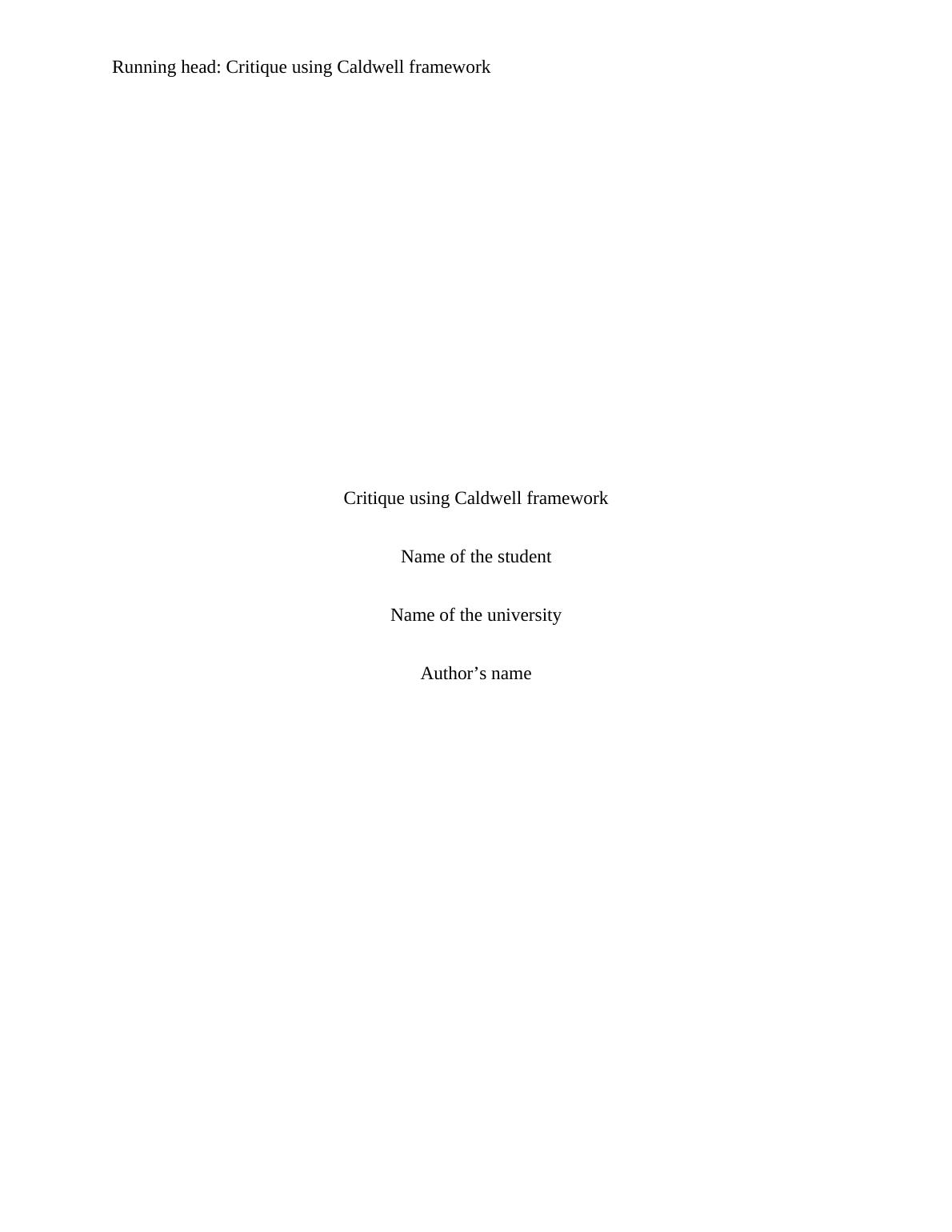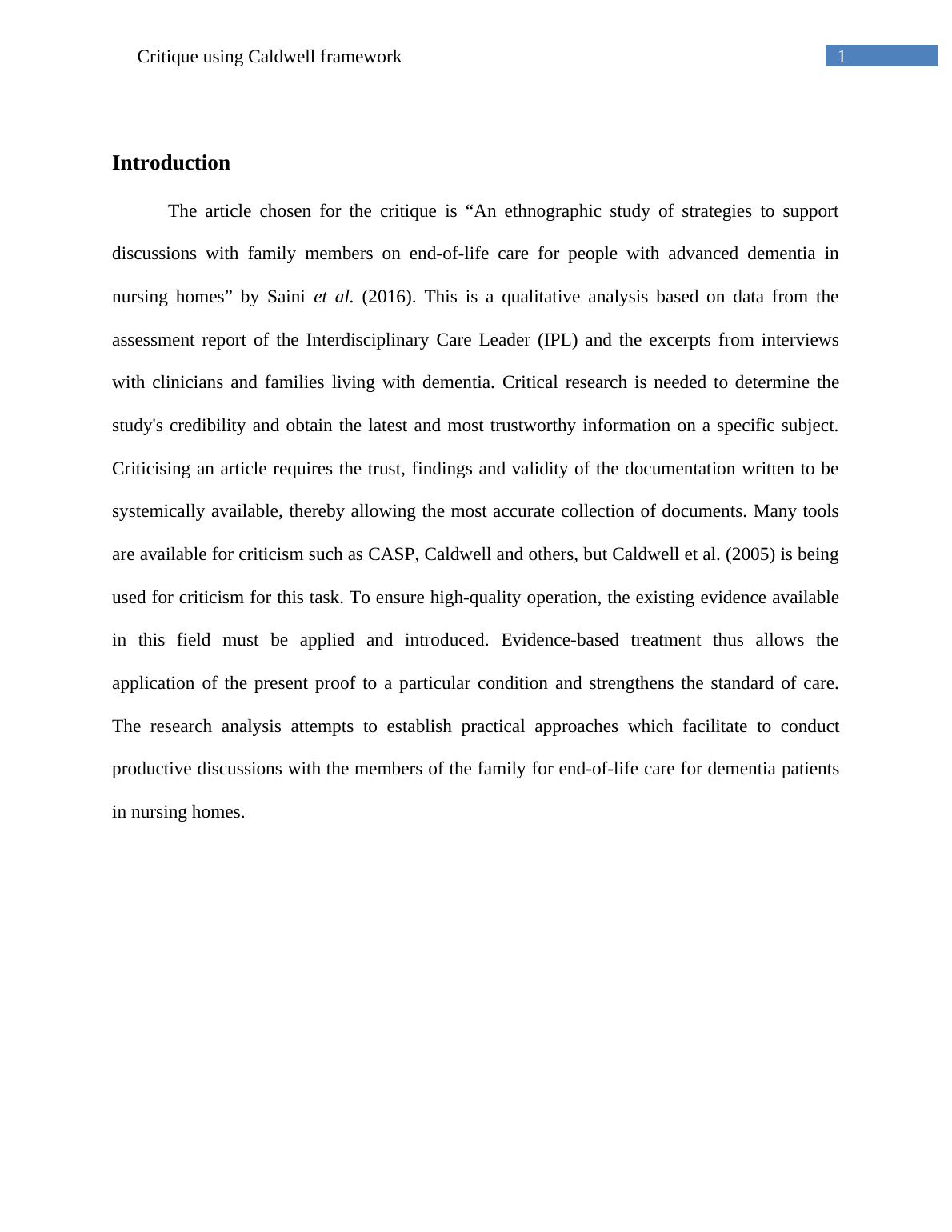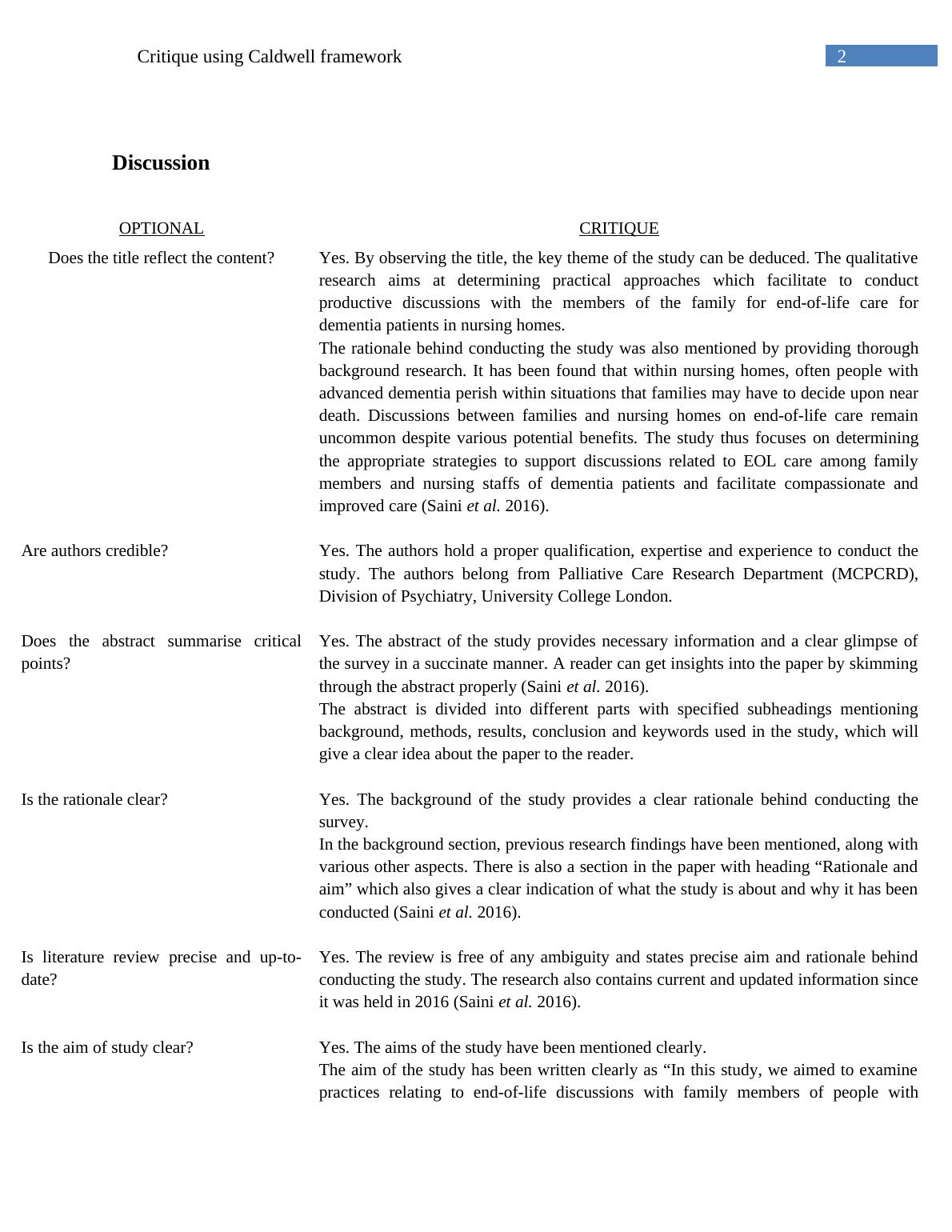Assignment on Critique Using Caldwell Framework
Added on 2022-08-30
9 Pages2850 Words102 Views
Running head: Critique using Caldwell framework
Critique using Caldwell framework
Name of the student
Name of the university
Author’s name
Critique using Caldwell framework
Name of the student
Name of the university
Author’s name

1Critique using Caldwell framework
Introduction
The article chosen for the critique is “An ethnographic study of strategies to support
discussions with family members on end-of-life care for people with advanced dementia in
nursing homes” by Saini et al. (2016). This is a qualitative analysis based on data from the
assessment report of the Interdisciplinary Care Leader (IPL) and the excerpts from interviews
with clinicians and families living with dementia. Critical research is needed to determine the
study's credibility and obtain the latest and most trustworthy information on a specific subject.
Criticising an article requires the trust, findings and validity of the documentation written to be
systemically available, thereby allowing the most accurate collection of documents. Many tools
are available for criticism such as CASP, Caldwell and others, but Caldwell et al. (2005) is being
used for criticism for this task. To ensure high-quality operation, the existing evidence available
in this field must be applied and introduced. Evidence-based treatment thus allows the
application of the present proof to a particular condition and strengthens the standard of care.
The research analysis attempts to establish practical approaches which facilitate to conduct
productive discussions with the members of the family for end-of-life care for dementia patients
in nursing homes.
Introduction
The article chosen for the critique is “An ethnographic study of strategies to support
discussions with family members on end-of-life care for people with advanced dementia in
nursing homes” by Saini et al. (2016). This is a qualitative analysis based on data from the
assessment report of the Interdisciplinary Care Leader (IPL) and the excerpts from interviews
with clinicians and families living with dementia. Critical research is needed to determine the
study's credibility and obtain the latest and most trustworthy information on a specific subject.
Criticising an article requires the trust, findings and validity of the documentation written to be
systemically available, thereby allowing the most accurate collection of documents. Many tools
are available for criticism such as CASP, Caldwell and others, but Caldwell et al. (2005) is being
used for criticism for this task. To ensure high-quality operation, the existing evidence available
in this field must be applied and introduced. Evidence-based treatment thus allows the
application of the present proof to a particular condition and strengthens the standard of care.
The research analysis attempts to establish practical approaches which facilitate to conduct
productive discussions with the members of the family for end-of-life care for dementia patients
in nursing homes.

2Critique using Caldwell framework
Discussion
OPTIONAL CRITIQUE
Does the title reflect the content? Yes. By observing the title, the key theme of the study can be deduced. The
qualitative research aims at determining practical approaches which facilitate to
conduct productive discussions with the members of the family for end-of-life
care for dementia patients in nursing homes.
The rationale behind conducting the study was also mentioned by providing
thorough background research. It has been found that within nursing homes,
often people with advanced dementia perish within situations that families may
have to decide upon near death. Discussions between families and nursing
homes on end-of-life care remain uncommon despite various potential benefits.
The study thus focuses on determining the appropriate strategies to support
discussions related to EOL care among family members and nursing staffs of
dementia patients and facilitate compassionate and improved care (Saini et al.
2016).
Are authors credible? Yes. The authors hold a proper qualification, expertise and experience to
conduct the study. The authors belong from Palliative Care Research
Department (MCPCRD), Division of Psychiatry, University College London.
Does the abstract summarise critical
points?
Yes. The abstract of the study provides necessary information and a clear
glimpse of the survey in a succinate manner. A reader can get insights into the
paper by skimming through the abstract properly (Saini et al. 2016).
The abstract is divided into different parts with specified subheadings
mentioning background, methods, results, conclusion and keywords used in the
study, which will give a clear idea about the paper to the reader.
Is the rationale clear? Yes. The background of the study provides a clear rationale behind conducting
the survey.
In the background section, previous research findings have been mentioned,
along with various other aspects. There is also a section in the paper with
heading “Rationale and aim” which also gives a clear indication of what the
study is about and why it has been conducted (Saini et al. 2016).
Is literature review precise and up-to-
date?
Yes. The review is free of any ambiguity and states precise aim and rationale
behind conducting the study. The research also contains current and updated
information since it was held in 2016 (Saini et al. 2016).
Discussion
OPTIONAL CRITIQUE
Does the title reflect the content? Yes. By observing the title, the key theme of the study can be deduced. The
qualitative research aims at determining practical approaches which facilitate to
conduct productive discussions with the members of the family for end-of-life
care for dementia patients in nursing homes.
The rationale behind conducting the study was also mentioned by providing
thorough background research. It has been found that within nursing homes,
often people with advanced dementia perish within situations that families may
have to decide upon near death. Discussions between families and nursing
homes on end-of-life care remain uncommon despite various potential benefits.
The study thus focuses on determining the appropriate strategies to support
discussions related to EOL care among family members and nursing staffs of
dementia patients and facilitate compassionate and improved care (Saini et al.
2016).
Are authors credible? Yes. The authors hold a proper qualification, expertise and experience to
conduct the study. The authors belong from Palliative Care Research
Department (MCPCRD), Division of Psychiatry, University College London.
Does the abstract summarise critical
points?
Yes. The abstract of the study provides necessary information and a clear
glimpse of the survey in a succinate manner. A reader can get insights into the
paper by skimming through the abstract properly (Saini et al. 2016).
The abstract is divided into different parts with specified subheadings
mentioning background, methods, results, conclusion and keywords used in the
study, which will give a clear idea about the paper to the reader.
Is the rationale clear? Yes. The background of the study provides a clear rationale behind conducting
the survey.
In the background section, previous research findings have been mentioned,
along with various other aspects. There is also a section in the paper with
heading “Rationale and aim” which also gives a clear indication of what the
study is about and why it has been conducted (Saini et al. 2016).
Is literature review precise and up-to-
date?
Yes. The review is free of any ambiguity and states precise aim and rationale
behind conducting the study. The research also contains current and updated
information since it was held in 2016 (Saini et al. 2016).

End of preview
Want to access all the pages? Upload your documents or become a member.
Related Documents
Article Critique Using Caldwell’s Frameworklg...
|7
|2228
|24
Critique Practicelg...
|10
|3142
|25
Critique of Quantitative Research on Care Delays in Patients with Acute Myocardial Infarctionlg...
|6
|1776
|376
Assignment on The Importance of Nursing Researchlg...
|14
|3411
|21
Patients Perception of Nurses Skilllg...
|5
|601
|233
Care Delays in Patients with Signs and Symptoms of Acute Myocardial Infarction: A Quantitative Research Critiquelg...
|11
|3403
|339
